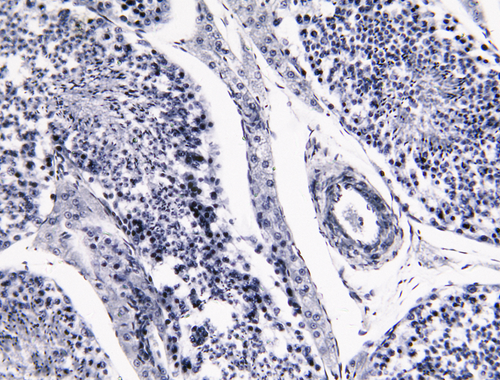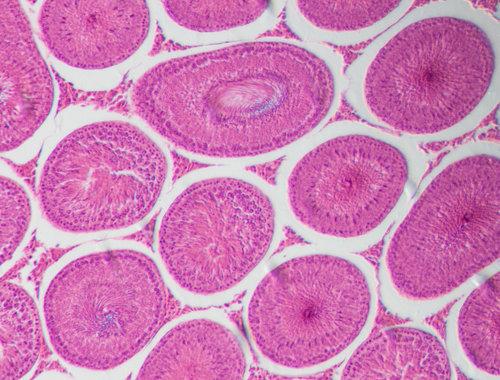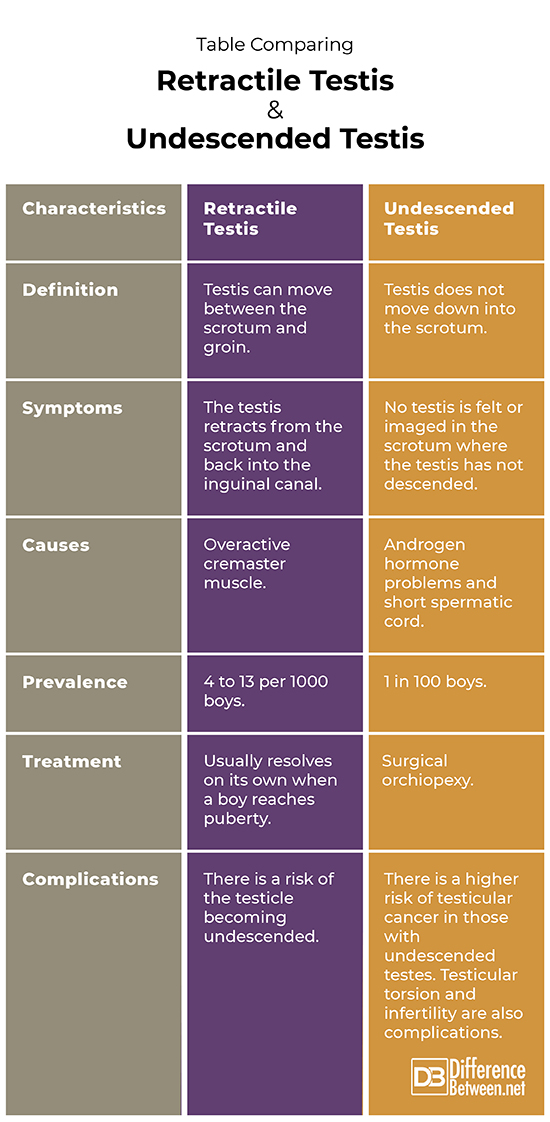Difference Between Retractile Testis and Undescended Testis
A retractile testis is one that can move back into the groin after having correctly moved down into the scrotal sac. An undescended testis is a testis that has not moved down into the scrotum.

What is Retractile testis
Definition:
The definition of a retractile testis is a testis that moves between the scrotum and the groin or abdominal area.
Causes and prevalence:
A retractile testis is due to an overactive cremaster muscle, which often contracts and pulls the testis up into the groin.
Symptoms and complications:
The symptoms are the testicle moving upwards into the groin and then moving back again into the scrotum. The only potential complication is that a retractile testis can become undescended.
Diagnosis:
Diagnosis is by physical exam and usually, the doctor can easily push the testis into the scrotum. This is not the case for an undescended testis.
Treatment:
Treatment is not needed for a retractile testis as it usually corrects on its own.

What is Undescended testis?
Definition:
An undescended testis (cryptorchidism) is when a testis does not go into the scrotum but remains either in the abdominal cavity or the inguinal canal. In male fetuses, the testes usually descend during the last three months of pregnancy. In undescended testes, this fails to happen.
Causes and prevalence:
There are likely a few causes of cryptorchidism related to hormones and the spermatic cord. One possible cause of an undescended testis is a problem with the androgen hormones needed for the process to occur. Acquired cryptorchidism is a condition caused by the spermatic cord not lengthening enough after birth. The condition is most common in premature (younger than 37 weeks), and low birth weight babies.
Symptoms and complications:
The scrotum has no testis present. An undescended testis puts a boy at risk of later developing infertility or even testicular cancer.
Diagnosis:
A physical exam is done where the doctor palpates the scrotum and notes that testes are absent. The undescended testes can sometimes be felt by the doctor but not always. Imaging tests may be needed to find where the testes are.
Treatment:
Treatment is by surgery. An orchiopexy is done in which the testis is moved from where it is currently located and placed into the scrotum where it is missing. Doctors recommend carrying out the surgery on baby boys before they reach a year old.
Difference between Retractile testis and Undescended testis?
Definition
A retractile testis is one that can move between the scrotum and groin. An undescended testis cannot move down into the scrotum.
Symptoms
In the case of a retractile testis, the testis retracts from the scrotum and back into the inguinal canal. In the case of an undescended testis, the testis can’t be felt or imaged in the scrotum because the testis has not descended.
Causes
The cause of a retractile testis is an overly active cremaster muscle. The causes of an undescended testis are thought to be an overly short spermatic cord and problems with the androgen hormones necessary for the testis to descend.
Prevalence
A retractile testis happens in 4 to 13 per 1000 boys. An undescended testis happens in 1 in 100 boys.
Treatment
Treatment is not needed for a retractile testis. Surgical orchiopexy is done to treat an undescended testis.
Complications
With a retractile testis, there is a risk of the testicle becoming undescended. With an undescended testis, the complications are testicular torsion, infertility, and testicular cancer.
Table comparing Retractile testis and Undescended testis

Summary of Retractile testis Vs. Undescended testis
- A retractile testis can move between the scrotum and inguinal canal.
- An undescended testis remains in the groin and does not move into the scrotum.
- There is an increased risk of infertility and cancer if you have an undescended testis.
FAQ
Can retractile testes become undescended?
Yes, it is possible for a retractile testis to remain up in the groin. If this happens, the condition is said to be an acquired undescended testis.
What is another name for undescended testis?
Cryptorchidism is an alternative name meaning undescended testis.
What is the difference between undescended testis and ectopic testis?
An undescended testis is not in the scrotum but is located somewhere along the normal path that it would descend along. An ectopic testis has not descended and is found in an unusual place and not in the normal path of descent.
When do you refer to retractile testes?
When testes did descend like they were supposed to but then retracted and moved back up into the inguinal canal.
Can you have kids with a retractile testicle?
Yes, it is possible for a man with a retractile testis to have children, but they may be less fertile than men with normal testicles.
How do you prevent testicular retractile?
Microsurgery done on the cremaster muscle can stop testicular retraction from re-occurring.
What is the cause of a retractile testicle?
The cause of a retractile testicle is an overactive cremaster muscle.
How do you examine a retractile testis?
A doctor can guide the testicle back into its proper place by palpation. Imaging methods can be used to locate a testicle if the doctor has problems locating it.
Does a retractile testicle affect testosterone?
It can affect testosterone, especially if a retractile testicle becomes undescended; in that case, a man is likely to have low levels of testosterone.
- Difference Between Rumination and Regurgitation - June 13, 2024
- Difference Between Pyelectasis and Hydronephrosis - June 4, 2024
- Difference Between Cellulitis and Erysipelas - June 1, 2024
Search DifferenceBetween.net :
References :
[0]Hutson, John M. "Undescended testis: the underlying mechanisms and the effects on germ cells that cause infertility and cancer." Journal of pediatric surgery 48.5 (2013): 903-908.
[1]Hutson, John M. "Undescended testis: the underlying mechanisms and the effects on germ cells that cause infertility and cancer." Journal of pediatric surgery 48.5 (2013): 903-908.
[2]Mayo Clinic. “Retractile testicle.” Diseases. Mayo Clinic, 2022, https://www.mayoclinic.org/diseases-conditions/retractile-testicle/symptoms-causes/syc-20377197
[3]Rabinowicz, R. and J. Cubillos. “Cryptorchordism (undescended testis)”. Merckmanuals. Merck & Co., 2022, https://www.msdmanuals.com/professional/pediatrics/congenital-renal-and-genitourinary-anomalies/cryptorchidism
